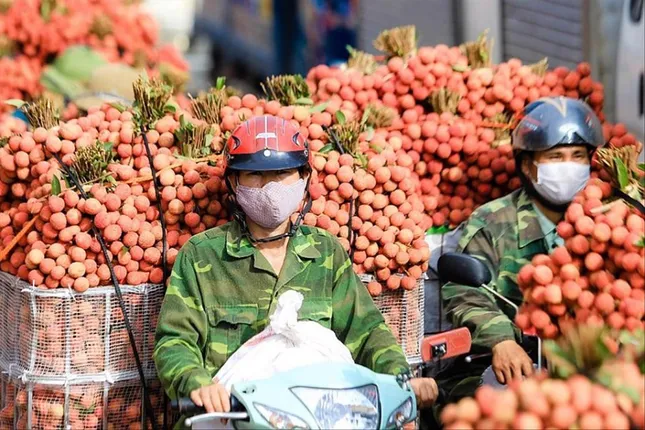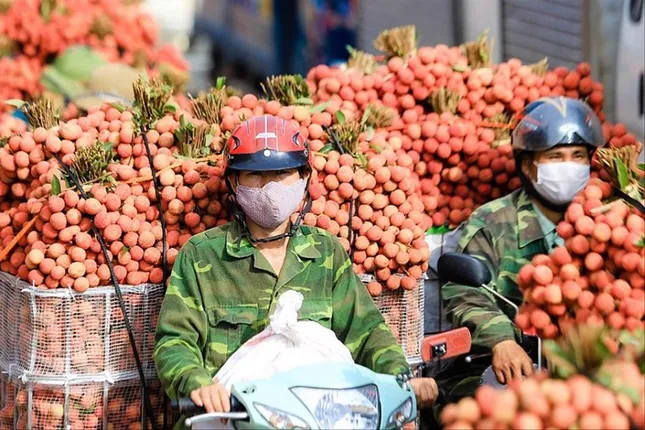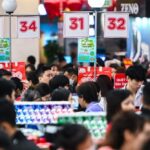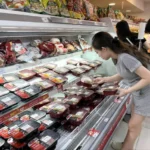Seasonal characteristics can lead to price drops
Speaking at the Trade Promotion Conference with the Vietnamese Trade Office Abroad in June 2025, organized by the Trade Promotion Agency, Ministry of Industry and Trade, with the participation of the Ministry of Agriculture and Environment and associations and enterprises.
Mr. Dang Phuc Nguyen, Secretary-General of the Vietnam Fruit and Vegetable Association, said that Vietnamese fruit and vegetables are present in more than 80 markets worldwide. China has always been the largest export market for Vietnamese fruit and vegetables, accounting for 65-70% of the total fruit and vegetable export turnover before 2025.
According to Mr. Nguyen, China is tightening import standards, shifting from unofficial to official trade, and requiring growing area codes, processing facilities, and other food safety standards. This is a challenge but also an opportunity for Vietnamese businesses to improve product quality.

Lychee is a high-potential export agricultural product that is in harvest season
The US is the second-largest market for Vietnamese fruit and vegetables, with export turnover growing significantly in recent years, but it also faces increasing quality requirements for key products, including coconut, durian, dragon fruit, mango, longan, lychee, and jackfruit.
“The demand for tropical fruits in the US is still high. However, the geographical distance affects quality and cost, requiring solutions in logistics and preservation technology to compete with South American and Southeast Asian countries. In the future, there will also be challenges regarding tariff barriers,” said Mr. Nguyen.
According to Mr. Nguyen, Vietnam’s agricultural sector, especially highly seasonal products such as lychee, longan, mango, jackfruit, dragon fruit, and durian, is under great pressure to maintain orders, market share, and improve competitiveness in the international market. The seasonal nature puts a lot of pressure on harvesting, transportation, and consumption, which can easily lead to congestion and price drops.
In addition, the world economy is inherently unstable, with a tendency to increase protectionism and non-tariff and tariff barriers. Moreover, relying on traditional markets (especially China) remains a significant risk when there are changes in tariff policies or standards.
Need to resolutely control quality sustainably
Mr. Nguyen Dinh Tung, Director of Vina T&T Group, a fruit exporter, shared that for many years, his company has been very successful in exporting green-skinned pomelo to the US market.
“Every season, we receive a lot of orders from the US market because our green-skinned pomelo is much better than that of other countries. However, we lack adequate promotional tools commensurate with the quality of our pomelo,” said Mr. Tung.
Mr. Tung suggested that there should be extensive forms of agricultural product promotion, such as organizing small and medium-sized exhibitions of Vietnamese agricultural products in foreign markets to reach a large number of global customers.
Ms. Ngo Thi Thu Hong, Deputy General Director of Ameii Vietnam Joint Stock Company, said that lychee is one of the key export products of the company to the US market.
However, to conquer this demanding market, the company has to make great efforts in quality control, spending a lot of time and money, especially transportation and logistics costs.
As there is no irradiation facility in the North, when lychees are harvested, the company has to transport them to the South for irradiation, then bring them back to the North for packaging and transportation to the US. “Transporting back and forth takes a lot of time and money and affects the competitiveness of Vietnamese lychees compared to other countries,” said Ms. Hong.
“We must strictly control the quality from the growing area, packaging house to the exporting enterprise. There needs to be a coordinating mechanism for cross-monitoring by forces to ensure consistent and stable quality.” – Mr. Vu Ba Phu, Director of the Trade Promotion Agency
Ms. Hong suggested that the Trade Promotion Agency of the Ministry of Industry and Trade provide detailed information about the needs of the local market so that enterprises can export products suitably and effectively. In addition, it is necessary to organize online trade connections so that enterprises can reach potential customers. Especially, it is necessary to build an irradiation facility in the North to help exporting enterprises save time and transportation costs in controlling the quality of exported agricultural products. It is also essential to expand lychee exports to the Korean market.
Mr. Nguyen Huu Quan, Head of the Vietnam Trade Office in Nanning (China), said that entering the summer, the fruit supply in the Chinese market is also more abundant, with domestic production of many types of fruit entering the main crop season, including lychee, longan, watermelon, and mango…
In addition, temperate fruits (apples, pears…) need to be cleared from warehouses to prepare for the new crop season. In terms of imports, suppliers in the ASEAN region, such as Thailand, Vietnam, and Malaysia, also start the main crop season for many types of fruit, especially durian. Meanwhile, the local consumer market after the Dragon Boat Festival often enters a sluggish state.
However, short-season fruits like lychees are still consumed strongly, especially in localities without this type of fruit.
Mr. Quan recommended that Vietnamese enterprises and industry associations need to strengthen the management and supervision of agricultural products, especially fresh fruits and vegetables, right at the production establishments and growing areas to ensure food hygiene and safety and traceable origin.
“Up to now, some of our fruits are still regularly warned due to failing to meet food safety standards and the presence of microorganisms that are subjects of quarantine regulations in the Protocol when exported to the local market,” said Mr. Quan.
“Sizzling Summer Sales: Businesses Cap Promotions at 50% Off from July 1st”
Let me know if you would like me to tweak it further or provide additional suggestions!
The upcoming implementation of the new circular by the Ministry of Industry and Trade, effective from July 1st, 2025, is a significant development. This circular meticulously outlines the maximum permissible limits for goods and services used in promotional activities, along with the maximum allowable discounts applicable in such promotional programs.
“Strategic Import Directive: Prime Minister Emphasizes Selective Sourcing to Balance Trade”
“The Prime Minister emphasizes the importance of proactive trade promotion strategies to facilitate selective imports of raw materials, components, equipment, and technology for domestic production. This strategic approach aims to balance the trade deficit in major markets such as the US and the EU.”
Pondering the Pork Conundrum: Hot or Cold?
Recent social media posts have caused a stir, with claims and images suggesting that pork supplied by C.P. Vietnam may be contaminated. The Ministry of Agriculture and Environment has referred the case to the police for investigation. This incident raises a critical question: How is the quality of pork, a staple food for many, being monitored and regulated?
The Plummeting Exports of Fruits and Vegetables: A Troubling Trend
“The Vietnamese fruit and vegetable industry experienced a significant downturn in the first five months of the year compared to the same period last year, according to Dang Phuc Nguyen, Secretary-General of the Vietnam Fruit and Vegetable Association (Vinafruit). This slump is a result of compounded market factors, casting doubt on the sector’s ability to meet its annual export targets.”





















